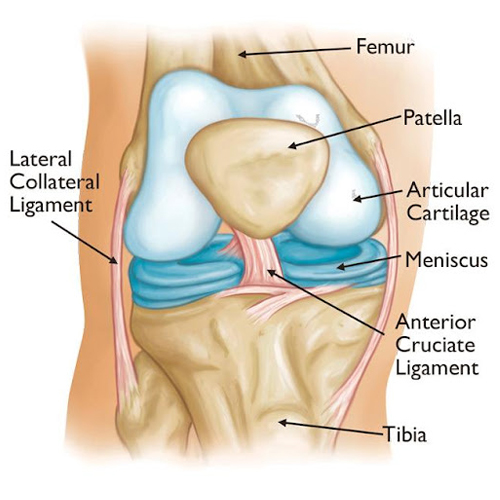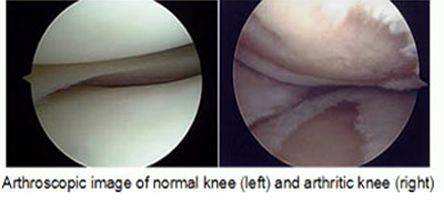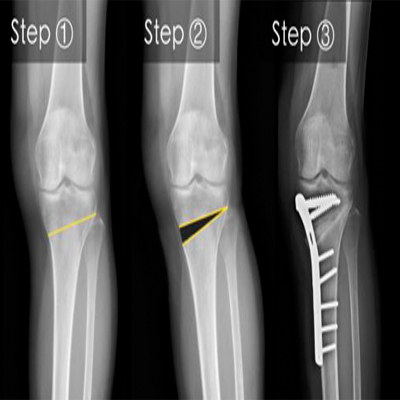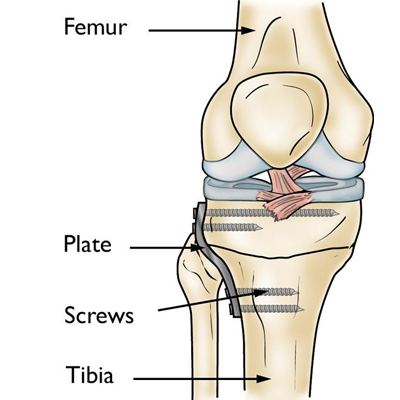Knee Replacement
Anatomy of the Knee


The knee joint is among the strongest, largest and most complex joints of the body. The healthy knee joint is a remarkable mechanism. It is formed by the bottom end of the femur (thigh bone), the top end of the tibia (shin bone) and the patella (knee cap). A healthy knee joint has cartilage between the bones that acts as padding. This padding helps assure a gliding movement of the knee that is both effortless and smooth. The healthy knee joint also has a joint capsule which houses the synovial membrane. This membrane produces lubricating fluid which contributes to the smooth movement of the knee.
Whenever you walk, sit, squat, turn around, drive or perform many other seemingly simple movements, you are depending on the knee for support and mobility. The human knee is designed to withstand a lifetime of stressful activity. However, sometimes arthritis intrudes, interfering with the knee’s ability to cushion the body from stress, and eventually causing the pain that dramatically erodes quality of life.
KNEE ARTHRITIS

Arthritis is not a symptom of “just getting old”. It is a degenerative or inflammatory disease of the joints that is not necessarily part of the normal aging process. Indeed, some patients with arthritis present symptoms in their 20s and 30s. Although there are several types of arthritis, one of the most common is called osteoarthritis. It affects millions of people in the world today.
Arthritis causes permanent deterioration of the cartilage layers that shield the joint from impact. Because cartilage cannot repair or replenish itself, it begins to crack, wear away and eventually disappear. The cushion the knee requires to absorb stress is gone, resulting in bone-on-bone contact. The bones in advanced cases may be so Rough and pitted from grinding against each other that they form bone spurs, which often cause stiffness.
In the first stage of osteoarthritis, the knee may feel stiff and swollen, followed by pain and some deformity too. Eventually, the mobility may become limited and you may need to alter your lifestyle to accommodate your sore, arthritic knee. If you are overweight or have a malalignment, the extra stress on the knee can accelerate the damage.
In the late stages of osteoarthritis, there is a severe pain in and around the knee, needing regular pain medications. Night pain or Rest pain may also be a feature with severe restrictions in ADL (Activities of Daily Living). There is a progressive loss of co-ordination and balance in walking, with a resultant higher risk of falling and sustaining other injuries. A common scenario in India where people tend to avoid recommended surgery and land up with other injuries post falls.
TREATMENT OF KNEE ARTHRITIS
Non-Operative Treatment
This includes medication, Lifestyle Management, Physiotherapy as appropriate plus mobility supports as indicated. Intraarticular injections of hyaluronic acid and cortisone are also used in early stages of arthritis or for those patients who are not candidates for surgical intervention for whatever reason.
Surgical Options
Arthroscopic Debridement

Used in situations wherein a degenerative meniscus tear complicates the early arthritic process, with the joint damage not severe enough to warrant a joint replacement. At best a temporising procedure with no real change to the underlying arthritic process.
Arthroscopic Debridement


A procedure to change the alignment of the knee to offload the damaged medial or inner knee compartment which is the earliest one to be involved in the arthritic process. This is not an option with more than one compartment involved by arthritis. Has the benefit of avoiding all the restrictions post knee replacement, but does not last for more than 7 to 8 years at best as progressive arthritis involves other knee compartments too.
KNEE REPLACEMENT AND TYPES
Surgery and manufacturers have made remarkable advances in joint replacement technology over the last few years. The materials are long-lasting and durable. The surgical aspects have been fine-tuned, the chances for a successful outcome are excellent.
In total knee replacement (also known as total knee arthroplasty, or TKA), the joint’s bone-end surfaces are resurfaced with man-made materials. In total knee arthroplasty, the implant (prosthesis) design may vary according to your needs, but the most common implant consists of three component parts. The patella, or knee cap, is made of high-density polyethylene, which offers tremendous strength and durability. The femoral section, or thigh bone, is metal, while the tibia, or shin bone, is made of metal tray with high density polyethylene cushioning attached to the tray. The implants are held in place with Bone Cement.
In Partial Knee Replacement, also known as Unicompartmental knee replacement, only the affected compartment usually medial compartment is replaced. The criteria for patient selection for this limited version of knee replacement are strict and the chosen patient has a faster rehabilitation with good results.
Revision Knee Replacement
A perfectly well-done knee Replacement may get infected or Instability may persist post knee replacement-these situations besides others may require a re do or revision knee replacement which increases patient morbidity and risks mortality too. Revision knee implants are more expensive and the procedure may involve 2 stages rather than a single stage surgery. The success rate of revision knee replacements is now approaching that of Primary knee replacement with availability of better implants and evolution of new techniques.
Benefits of Knee Replacement
- Reduced joint pain (may be no pain!)
- Increased movement and mobility for e.g. Walking, stair climbing, etc.
- Stable Joint.
- Straight Joint (Correction of deformity)
- Increased leg strength (if you exercise)
- Improved quality of life-ability to return to normal activities and pastimes. Restrictions post knee Replacement
- NO sitting on the floor or squatting, Avoid cross legged sitting beside running, jumping and other high impact activities
FAQ's On Knee Replacement
What exercises I need to do after surgery?
We shall make you walk with support about 1-2 days after your surgery. Moreover, you will start to bend your new joint and do the movements during the same time. We shall take care of your pain by different medications and you will be able to do it with the help of our expert team of physiotherapists and occupational therapists.
What are the disadvantages of this operation?
There is less than 1% chance of infection in the world’s best centres. We match the international standards by having strict operation theatre protocol, antibiotics, infection control team and discipline in the ward itself. Other complications are minor and it is possible to avoid if you strictly follow the advice of your doctor and therapists.
How long an artificial joint last?
We give an average life span of about 10-15 years. But the longest surviving artificial joint is 30 years in the world. It also depends on how you take care of your new joint.
Will it affect my day-to-day life?
The surgery will lead to better quality of life and you can do your day-to-day activities normally. The restrictions alluded to above have to be strictly adhered to, for maximum longevity of the artificial knee replacement.
